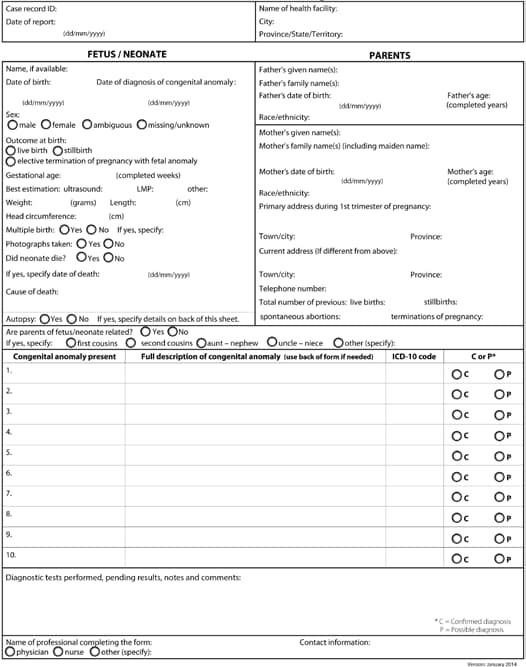3.9 Core Ascertainment Variables
On this Page
Expected time: 1.5 hours
The objectives and goals of a surveillance programme will drive what the programme will choose as its core ascertainment variables. Countries should assess the availability of core variables on existing data sources to determine what important information on congenital anomalies is already being collected for other analytical purposes.
Activity 3.3
Ask participants to refer to Activity 3.3 in the Participant Workbook pdf icon[457 KB, 21 Pages, Print Only].
| Category | Variable name | Why this variable should be collected |
| Report | Case record identification | |
| City, province, state, or territory | ||
| Father | Name(s) | |
| Mother | Name(s) | |
| Mother’s date of birth, or age if date of birth is not available | ||
| Total number of pregnancies | ||
| Infant | Date of birth | |
| Sex | ||
| Outcome at birth |
Discuss how variables might differ, depending on the participant’s country, and how they would be adapted. Direct participants to Appendices H and I in WHO/CDC/ICBDSR Birth defects surveillance: a manual for programme managers (4) for additional variables to consider.
Once they have completed the table, show participants the following table with possible responses for further discussion.
| Category | Variable name | Why this variable should be collected (responses in italics below) |
| Report | Case record identification | To retrieve a form, and ensure that it is not duplicated in the database |
| City, province, state, or territory | To identify the prevalence of congenital anomalies by place of birth | |
| Father | Name(s) | To retrieve information, link infant |
| Mother | Name(s) | To retrieve information, link infant |
| Mother’s date of birth, or age if date of birth is not available | To identify the distribution and prevalence of congenital anomalies by maternal age (maternal age is a risk factor for some congenital anomalies) | |
| Total number of pregnancies | To identify the distribution and prevalence of congenital anomalies by previous parity | |
| Infant | Date of birth | To retrieve information, and to ascertain the distribution of congenital anomalies by month/year |
| Sex | To identify the distribution of congenital anomalies by sex | |
| Outcome at birth | To identify the distribution and prevalence of congenital anomalies by pregnancy outcome. Prevalence can be calculated by live births with or without stillbirths and ETOPFA |
Activity 3.4
Ask participants to refer to Activity 3.4 in the Participant Workbookpdf icon.
Show the example of an abstraction form. Ask participants to consider the form, based on how they plan to collect data (paper-based or electronic collection) and which variables they would add or delete, and why.
Ask the following questions, to generate discussion:
- What demographic variables would be important to include in a surveillance programme for your country?
- What are the estimated rates of consanguinity in your country?
- Do you think it might be important to ask about consanguinity? Why or why not?
- What race/ethnicities might be useful to capture?
- Do you think it is important to collect information about ethnicity? Why or why not?
- What data are already being collected from existing vital registries and hospital logbooks in your country, and are they available?
- World Health Organization. Congenital anomalies. Fact sheet No 370. October 2012 (http://www.who.int/mediacentre/factsheets/fs370/en/index.htmlexternal icon , accessed 29 April 2015).
- Resolution WHA63.17. Birth defects. In: Sixty-third World Health Assembly, Geneva,17–21 May 2010. Geneva: World Health Organization; 2010 (http://apps.who.int/gb/ebwha/pdf_files/WHA63/A63_R17-en.pdfexternal icon, accessed 29 April 2015).
- International statistical classification of diseases and related health problems, 10th revision. Geneva: World Health organization; 2015 (http://apps.who.int/classifications/icd10/browse/2015/enexternal icon , accessed 24 February 2015).
- World Health Organization, National Center on Birth Defects and Developmental Disabilities from the United States Centers for Disease Control and Prevention (CDC), International Clearinghouse for Birth Defects Surveillance and Research (ICBDSR). Birth defects surveillance: a manual for programme managers. Geneva: World Health Organization; 2014 (https://www.cdc.gov/ncbddd/birthdefectscount/documents/bd-surveillance-manual.pdf, accessed 10 February 2015).
- World Health Organization, National Center on Birth Defects and Developmental Disabilities from the United States Centers for Disease Control and Prevention(CDC), International Clearinghouse for Birth Defects Surveillance and Research (ICBDSR). Birth defects surveillance: atlas of selected congenital anomalies. Geneva: World Health Organization; 2014 (http://apps.who.int/iris/bitstream/10665/127941/1/9789241564762_eng.pdf?ua=1pdf iconexternal icon , accessed 10 February 2015).
- CDC Foundation. What is public health? (http://www.cdcfoundation.org/content/what-public-healthexternal icon , accessed 24 February 2015).
